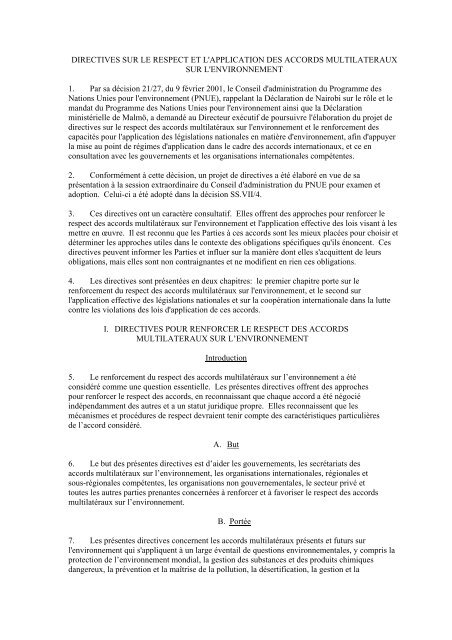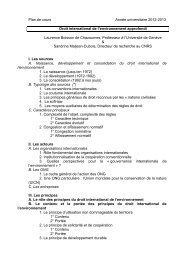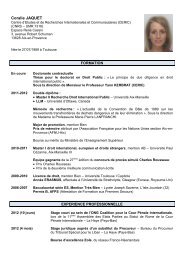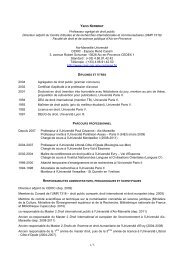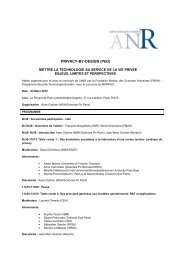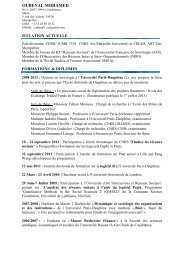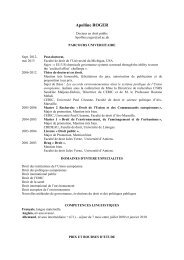Directives sur le respect et l'application des accords ... - UNEP
Directives sur le respect et l'application des accords ... - UNEP
Directives sur le respect et l'application des accords ... - UNEP
Create successful ePaper yourself
Turn your PDF publications into a flip-book with our unique Google optimized e-Paper software.
Økologiske responser tilframtidige klimaendringer• Synliggjøre effekter av global oppvarming• Tydeliggjøre utfordringer vi står foran• Plan<strong>le</strong>gge langsiktige forvaltningsmessigestrategier
<strong>des</strong> capacités <strong>et</strong> de transfert de technologie ou d'entreprendre <strong>des</strong> activités conjointes lorsqu’ils’agit de questions intersectoriel<strong>le</strong>s, par souci de rentabilité <strong>et</strong> pour éviter <strong>le</strong>s doub<strong>le</strong>s emplois.F. Coopération internationa<strong>le</strong>34. Il est admis que tous <strong>le</strong>s pays doivent s'impliquer dans <strong>le</strong> processus mondial de protection <strong>et</strong>d'amélioration de l'environnement. L'Organisation <strong>des</strong> Nations Unies <strong>et</strong> d'autres organisationsinternationa<strong>le</strong>s compétentes, ainsi que <strong>des</strong> initiatives multilatéra<strong>le</strong>s <strong>et</strong> bilatéra<strong>le</strong>s visant àpromouvoir <strong>et</strong> renforcer <strong>le</strong> <strong>respect</strong> <strong>des</strong> <strong>accords</strong> peuvent y contribuer. A c<strong>et</strong> égard, <strong>des</strong> me<strong>sur</strong>espeuvent être prises pour :a) Produire <strong>des</strong> informations en vue de faire <strong>le</strong> point de la situation en ce qui concerne <strong>le</strong><strong>respect</strong> <strong>des</strong> <strong>accords</strong> multilatéraux <strong>sur</strong> l'environnement <strong>et</strong> de définir, par <strong>le</strong> biais de consultations,<strong>des</strong> moyens de <strong>le</strong> favoriser <strong>et</strong> de <strong>le</strong> renforcer;b) Développer <strong>et</strong> renforcer <strong>le</strong>s capacités <strong>des</strong> pays en développement, en particulier <strong>des</strong>pays <strong>le</strong>s moins avancés, ainsi que <strong>des</strong> pays à économie en transition <strong>et</strong> <strong>le</strong>ur transférer <strong>des</strong>technologies;c) M<strong>et</strong>tre en commun <strong>le</strong>s données d'expérience nationa<strong>le</strong>s en matière de gestion del'environnement;d) Faire évaluer par <strong>le</strong>s conférences <strong>des</strong> Parties, dans <strong>le</strong> cadre de l’examen global del'efficacité <strong>des</strong> <strong>accords</strong> multilatéraux <strong>respect</strong>ifs <strong>sur</strong> l’environnement, l'efficacité <strong>des</strong> mécanismescréés en vertu de ces <strong>accords</strong> multilatéraux <strong>sur</strong> l'environnement pour <strong>le</strong> transfert de technologie <strong>et</strong>de ressources financières;e) Aider à l’élaboration de documents d'orientation qui pourront comporter unelégislation type pour la mise en œuvre <strong>des</strong> <strong>accords</strong> multilatéraux <strong>sur</strong> l’environnement afin d'enrenforcer <strong>le</strong> <strong>respect</strong>;f) Elaborer <strong>des</strong> plans d'action ou <strong>des</strong> stratégies en faveur de l'environnement auxniveaux régional ou sous-régional pour faciliter <strong>l'application</strong> <strong>des</strong> <strong>accords</strong> multilatéraux <strong>sur</strong>l'environnement;g) Faire connaître aux non-parties <strong>le</strong>s droits, <strong>le</strong>s avantages <strong>et</strong> <strong>le</strong>s obligations liés à laqualité de Partie à un accord multilatéral <strong>sur</strong> l'environnement <strong>et</strong> inviter <strong>le</strong>s non-parties commeobservateurs aux réunions <strong>des</strong> organes décisionnels d'<strong>accords</strong> multilatéraux <strong>sur</strong> l'environnementpour qu'ils connaissent <strong>et</strong> comprennent mieux ces <strong>accords</strong>;h) Renforcer la coopération entre <strong>le</strong>s secrétariats d'<strong>accords</strong> multilatéraux <strong>sur</strong>l'environnement, si <strong>le</strong>s Parties à ces <strong>accords</strong> <strong>le</strong> demandent.8
II. DIRECTIVES POUR L’APPLICATION EFFECTIVE DES LEGISLATIONSNATIONALES ET LA COOPERATION INTERNATIONALE DANS LALUTTE CONTRE LES VIOLATIONS DES LOIS D’APPLICATION DESACCORDS MULTILATERAUX SUR L’ENVIRONNEMENTIntroduction35. Les présentes directives reconnaissent que, pour m<strong>et</strong>tre en oeuvre <strong>le</strong>s <strong>accords</strong> multilatéraux<strong>sur</strong> l’environnement, il faut <strong>des</strong> lois d’application effectives au plan national. Une applicationeffective <strong>des</strong> lois est essentiel<strong>le</strong> pour en r<strong>et</strong>irer tous <strong>le</strong>s avantages possib<strong>le</strong>s, protégerl'environnement <strong>et</strong> la santé <strong>et</strong> la sécurité du public, décourager <strong>le</strong>s violations <strong>et</strong> encourager unemeil<strong>le</strong>ure exécution. Les présentes directives reconnaissent aussi qu'une coopération <strong>et</strong> unecoordination internationa<strong>le</strong>s sont nécessaires pour faciliter <strong>et</strong> favoriser une application effective<strong>des</strong> <strong>accords</strong> multilatéraux <strong>sur</strong> l'environnement mis en œuvre <strong>et</strong> aider à établir <strong>des</strong> règ<strong>le</strong>s du jeuéquitab<strong>le</strong>s au niveau international.A. But36. Les présentes directives décrivent <strong>le</strong>s actions <strong>et</strong> <strong>le</strong>s me<strong>sur</strong>es que <strong>le</strong>s Etats peuventenvisager pour renforcer l’application effective <strong>des</strong> législations nationa<strong>le</strong>s <strong>et</strong> la coopérationinternationa<strong>le</strong> dans la lutte contre <strong>le</strong>s violations <strong>des</strong> lois d'application <strong>des</strong> <strong>accords</strong>multilatéraux <strong>sur</strong> l'environnement. El<strong>le</strong>s peuvent aider <strong>le</strong>s gouvernements, <strong>le</strong>s autoritéscompétentes, <strong>le</strong>s organismes chargés de <strong>l'application</strong> <strong>des</strong> lois, <strong>le</strong>s secrétariats <strong>des</strong> <strong>accords</strong>multilatéraux <strong>sur</strong> l'environnement, s'il y a lieu, <strong>et</strong> d'autres organisations internationa<strong>le</strong>s <strong>et</strong>régiona<strong>le</strong>s compétentes à m<strong>et</strong>tre au point <strong>le</strong>s outils, <strong>le</strong>s mécanismes <strong>et</strong> <strong>le</strong>s techniquesnécessaires à c<strong>et</strong> égard.B. Portée37. Les présentes directives portent <strong>sur</strong> <strong>l'application</strong> effective <strong>des</strong> lois <strong>et</strong> <strong>des</strong> règ<strong>le</strong>mentsnationaux d'application <strong>des</strong> <strong>accords</strong> multilatéraux <strong>sur</strong> l'environnement, dans un vaste contexteoù <strong>le</strong>s Etats, conformément aux obligations qui <strong>le</strong>ur incombent en vertu de ces instruments,m<strong>et</strong>tent en place une législation <strong>et</strong> <strong>des</strong> institutions pour soutenir l’application effective <strong>des</strong>lois <strong>et</strong> prennent <strong>des</strong> me<strong>sur</strong>es pour décourager <strong>le</strong>s violations <strong>des</strong> lois environnementa<strong>le</strong>s <strong>et</strong> <strong>le</strong>scontraventions à ces lois. Les approches suivies consistent notamment à promouvoirl'adoption de lois <strong>et</strong> règ<strong>le</strong>ments appropriés <strong>et</strong> efficaces pour intervenir comme il convient encas de violations <strong>des</strong> lois environnementa<strong>le</strong>s <strong>et</strong> de délits environnementaux. Les présentesdirectives font la place voulue au développement <strong>des</strong> capacités institutionnel<strong>le</strong>s grâce à unecoopération <strong>et</strong> à une coordination entre organisations internationa<strong>le</strong>s pour rendre <strong>l'application</strong>plus effective.C. Définitions38. Aux fins du présent chapitre <strong>des</strong> directives :a) Le terme «<strong>respect</strong>» désigne <strong>le</strong>s conditions de conformité aux obligations,imposées par un Etat <strong>et</strong> par ses autorités <strong>et</strong> organismes compétents à une col<strong>le</strong>ctivité soumiseà une rég<strong>le</strong>mentation, soit directement, soit par <strong>le</strong> biais de conditions <strong>et</strong> d’exigences prévuesdans <strong>des</strong> permis, <strong>des</strong> licences <strong>et</strong> <strong>des</strong> autorisations, dans la mise en œuvre d'<strong>accords</strong>multilatéraux <strong>sur</strong> l’environnement 2 ;2 Eu égard au fait que <strong>le</strong> terme "<strong>respect</strong>" a une signification particulière dans <strong>le</strong>s domaines couverts par<strong>le</strong>s deux chapitres <strong>et</strong> que ceux qui s'occupent de ces domaines <strong>le</strong> connaissant <strong>et</strong> <strong>le</strong> comprennent bien9
a) L'assignation de responsabilités à <strong>des</strong> organismes pour :i) As<strong>sur</strong>er <strong>l'application</strong> effective de la législation <strong>et</strong> de la rég<strong>le</strong>mentation;ii)iii)iv)Suivre <strong>et</strong> évaluer la mise en œuvre;Recueillir, communiquer <strong>et</strong> analyser <strong>le</strong>s données, y compris <strong>le</strong>ur vérificationqualitative <strong>et</strong> quantitative, <strong>et</strong> fournir <strong>des</strong> informations <strong>sur</strong> <strong>le</strong>s enquêtes;Sensibiliser <strong>et</strong> faire de la publicité, en particulier au sein de la col<strong>le</strong>ctivitésoumise à la rég<strong>le</strong>mentation, <strong>et</strong> as<strong>sur</strong>er l'éducation du public;v) Fournir une aide aux tribunaux <strong>et</strong> à d'autres institutions apparentées, selon qu’ilconviendra, étayée éventuel<strong>le</strong>ment par <strong>des</strong> informations <strong>et</strong> données pertinentes;b) Le contrô<strong>le</strong> de l'importation <strong>et</strong> de l'exportation d'espèces menacées d’extinction<strong>et</strong> de substances, y compris <strong>le</strong> suivi <strong>des</strong> expéditions, l'inspection <strong>et</strong> d'autres activitésd'application aux frontières, dans <strong>le</strong>s ports <strong>et</strong> dans d'autres endroits où une activité illéga<strong>le</strong> estconnue ou soupçonnée;c) Une habilitation claire <strong>des</strong> organismes d’application <strong>et</strong> d'autres entités quiparticipent à <strong>des</strong> activités d'application effective pour :i) Obtenir <strong>des</strong> renseignements <strong>sur</strong> <strong>le</strong>s aspects pertinents de <strong>l'application</strong>;ii)iii)iv)Avoir accès aux installations appropriées, notamment <strong>le</strong>s ports <strong>et</strong> <strong>le</strong>s points depassage <strong>des</strong> frontières;Contrô<strong>le</strong>r <strong>et</strong> vérifier <strong>le</strong> <strong>respect</strong> de la législation <strong>et</strong> de la rég<strong>le</strong>mentationnationa<strong>le</strong>s;Ordonner <strong>des</strong> me<strong>sur</strong>es pour prévenir <strong>le</strong>s violations <strong>des</strong> lois environnementa<strong>le</strong>s<strong>et</strong> poury remédier;v) As<strong>sur</strong>er une coordination avec d'autres organismes;vi)Imposer <strong>des</strong> sanctions, notamment <strong>des</strong> pénalités, en cas de violation <strong>et</strong> de non<strong>respect</strong><strong>des</strong> lois environnementa<strong>le</strong>s.d) Des politiques <strong>et</strong> <strong>des</strong> procédures as<strong>sur</strong>ant une application effective équitab<strong>le</strong> <strong>et</strong>cohérente <strong>et</strong> l'imposition de pénalités fondées <strong>sur</strong> <strong>des</strong> critères <strong>et</strong> <strong>des</strong> directives répressivesétablis qui, par exemp<strong>le</strong>, tiennent compte de la gravité relative du dommage, <strong>des</strong> antécédentsen matière de non-<strong>respect</strong> ou de violation <strong>des</strong> lois environnementa<strong>le</strong>s, du coût <strong>des</strong> me<strong>sur</strong>escorrectives <strong>et</strong> <strong>des</strong> profits illicites;e) Des critères pour <strong>le</strong>s priorités en matière d'application effective, qui peuvent êtrebasés <strong>sur</strong> <strong>le</strong>s dommages causés ou <strong>le</strong>s risques pour l'environnement, <strong>le</strong> type ou la gravité de laviolation <strong>des</strong> lois environnementa<strong>le</strong>s ou la zone géographique;f) La création ou <strong>le</strong> renforcement de services nationaux de répression <strong>des</strong> délitsenvironnementaux pour compléter <strong>le</strong>s programmes civils <strong>et</strong> administratifs d'application effective;11
g) Le recours à <strong>des</strong> instruments économiques, y compris <strong>des</strong> redevancesd'utilisation, <strong>des</strong> pénalités en cas de pollution <strong>et</strong> d'autres me<strong>sur</strong>es en faveur d'un <strong>respect</strong>économiquement efficace;h) Des systèmes de certification;i) L'accès du public <strong>et</strong> de la société civi<strong>le</strong> aux procédures administratives <strong>et</strong>judiciaires pour contester <strong>des</strong> actes <strong>et</strong> <strong>des</strong> omissions <strong>des</strong> pouvoirs publics <strong>et</strong> de personnesmora<strong>le</strong>s qui vio<strong>le</strong>nt <strong>le</strong>s lois <strong>et</strong> règ<strong>le</strong>ments nationaux <strong>sur</strong> l'environnement, y compris un soutienpour l'accès du public à la justice, compte dûment tenu <strong>des</strong> différences dans <strong>le</strong>s systèmesjuridiques <strong>et</strong> <strong>des</strong> circonstances;j) L'accès du public aux informations <strong>sur</strong> l'environnement que détiennent <strong>le</strong>sgouvernements <strong>et</strong> <strong>le</strong>s organismes compétents, conformément au droit national <strong>et</strong> au droitinternational applicab<strong>le</strong> concernant l'accès, la transparence <strong>et</strong> <strong>le</strong> traitement appropriéd'informations confidentiel<strong>le</strong>s ou protégées;k) Les responsabilités <strong>et</strong> <strong>le</strong>s processus de participation de la col<strong>le</strong>ctivité concernée<strong>et</strong> <strong>des</strong> organisations non gouvernementa<strong>le</strong>s pour contribuer à la protection de l'environnement;l) L’information <strong>des</strong> organes législatifs, exécutifs <strong>et</strong> d’autres organismes publics ausuj<strong>et</strong> <strong>des</strong> me<strong>sur</strong>es prises en faveur de l’environnement <strong>et</strong> <strong>des</strong> résultats obtenus;m) Le recours aux médias pour faire connaître <strong>le</strong>s violations <strong>et</strong> <strong>le</strong>s me<strong>sur</strong>esd'application <strong>des</strong> lois environnementa<strong>le</strong>s, tout en citant <strong>des</strong> exemp<strong>le</strong>s de bons résultats dans <strong>le</strong>domaine de l'environnement;n) Un examen périodique de la pertinence <strong>des</strong> lois, règ<strong>le</strong>ments <strong>et</strong> politiquesexistants du point de vue de la réalisation de <strong>le</strong>urs objectifs environnementaux.o) L’établissement de tribunaux en me<strong>sur</strong>e d'imposer <strong>le</strong>s pénalités appropriées pourviolation de la législation <strong>et</strong> de la rég<strong>le</strong>mentation environnementa<strong>le</strong>s, ainsi que d’autresconséquences.3. Coordination nationa<strong>le</strong>42. Une application effective au plan national peut être facilitée par une coordination entre <strong>le</strong>sautorités <strong>et</strong> <strong>le</strong>s organismes compétents, <strong>et</strong> notamment par :a) Une coordination entre divers organismes d'application effective, <strong>le</strong>s autoritésenvironnementa<strong>le</strong>s <strong>et</strong> <strong>le</strong>s fonctionnaires <strong>des</strong> impôts, <strong>des</strong> douanes <strong>et</strong> autres fonctionnairescompétents, à différents échelons de l'administration, ainsi que l'établissement de liens <strong>sur</strong> <strong>le</strong>terrain entre <strong>le</strong>s équipes de travail interorganisations <strong>et</strong> points de contact, notamment laconclusion, <strong>le</strong> cas échéant, d’<strong>accords</strong> officiels tels que mémorandums d’accord <strong>et</strong> règ<strong>le</strong>s enmatière de communication ainsi que la formulation de directives;b) Une coordination <strong>des</strong> organismes publics avec <strong>le</strong>s organisations nongouvernementa<strong>le</strong>s <strong>et</strong> <strong>le</strong> secteur privé;c) Une coordination entre <strong>le</strong>s autorités chargées de promouvoir <strong>des</strong> systèmesd'autorisations afin de rég<strong>le</strong>menter <strong>et</strong> de contrô<strong>le</strong>r l'importation <strong>et</strong> l'exportation de substancesillicites <strong>et</strong> de matières dangereuses, y compris <strong>le</strong>s substances chimiques <strong>et</strong> <strong>le</strong>s déch<strong>et</strong>srég<strong>le</strong>mentés.12
4. Formation pour <strong>le</strong> renforcement <strong>des</strong> capacités d'application effective43. Les activités de formation pour <strong>le</strong> renforcement <strong>des</strong> capacités d'application effective peuventcomprendre :a) Des programmes de sensibilisation <strong>des</strong> organismes d'application effective à <strong>le</strong>urrô<strong>le</strong> <strong>et</strong> à <strong>le</strong>ur importance dans <strong>l'application</strong> de la législation <strong>et</strong> de la rég<strong>le</strong>mentationenvironnementa<strong>le</strong>s;b) Une formation <strong>des</strong> procureurs, <strong>des</strong> magistrats, du personnel chargé de<strong>l'application</strong> <strong>des</strong> lois environnementa<strong>le</strong>s, <strong>des</strong> douaniers <strong>et</strong> d'autres responsab<strong>le</strong>s en matièrecivi<strong>le</strong>, péna<strong>le</strong> <strong>et</strong> administrative, y compris <strong>des</strong> instructions <strong>sur</strong> diverses formes de preuves, <strong>le</strong>traitement <strong>des</strong> affaires <strong>et</strong> <strong>le</strong>s poursuites, ainsi que <strong>sur</strong> l'imposition de pénalités appropriées;c) Une formation <strong>des</strong> juges, <strong>des</strong> magistrats <strong>et</strong> <strong>des</strong> auxiliaires de justice auxquestions concernant la nature <strong>et</strong> <strong>l'application</strong> effective <strong>des</strong> lois <strong>et</strong> <strong>des</strong> règ<strong>le</strong>mentsenvironnementaux, ainsi que <strong>le</strong>s dommages <strong>et</strong> <strong>le</strong>s coûts causés par la violation de ces lois <strong>et</strong>règ<strong>le</strong>ments;d) Une formation pour aider à créer une communauté de vues entre <strong>le</strong>s responsab<strong>le</strong>sde la rég<strong>le</strong>mentation, <strong>le</strong> personnel chargé de l’application <strong>des</strong> lois <strong>sur</strong> l’environnement, <strong>le</strong>sprocureurs <strong>et</strong> <strong>le</strong>s juges, afin que tous <strong>le</strong>s maillons du processus comprennent <strong>le</strong>s rô<strong>le</strong>s <strong>des</strong> uns<strong>et</strong> <strong>des</strong> autres;e) Une formation du personnel chargé de l’application <strong>des</strong> lois <strong>sur</strong> l’environnement,y compris une formation pratique aux techniques d'inspection <strong>et</strong> une formation poussée auxtechniques <strong>des</strong> enquêtes, notamment à la <strong>sur</strong>veillance, à l’inspection <strong>des</strong> lieux <strong>des</strong> délits <strong>et</strong> auxexamens criminalistes;f) Le développement <strong>des</strong> capacités de coordination <strong>des</strong> actions entre organismesresponsab<strong>le</strong>s, au plan national <strong>et</strong> international, de partage <strong>des</strong> données <strong>et</strong> d'utilisation de latechnologie de l'information pour promouvoir une application effective;g) Le développement de capacités pour concevoir <strong>et</strong> utiliser efficacement <strong>des</strong>instruments économiques afin de renforcer <strong>le</strong> <strong>respect</strong>;h) L'élaboration de moyens novateurs d’obtenir, de mobiliser <strong>et</strong> de conserver <strong>des</strong>ressources humaines <strong>et</strong> financières pour renforcer <strong>l'application</strong> effective;i) L’application <strong>des</strong> techniques d’analyse <strong>des</strong> renseignements pour classer <strong>et</strong>analyser <strong>le</strong>s données <strong>et</strong> fournir <strong>des</strong> informations en vue d'aider à utiliser <strong>le</strong>s ressources pouridentifier <strong>le</strong>s auteurs de délits environnementaux.5. Sensibilisation <strong>et</strong> éducation du public dans <strong>le</strong> domaine de l'environnement44. La sensibilisation <strong>et</strong> l'éducation du public dans <strong>le</strong> domaine de l'environnement peuvent êtreaméliorées par <strong>le</strong>s me<strong>sur</strong>es suivantes :a) Sensibiliser <strong>le</strong> public, en particulier <strong>le</strong>s groupes cib<strong>le</strong>s, à la législation <strong>et</strong> à larég<strong>le</strong>mentation pertinentes en matière d'environnement <strong>et</strong> à <strong>le</strong>urs droits, intérêts, devoirs <strong>et</strong>responsabilités, ainsi qu'aux conséquences socia<strong>le</strong>s, environnementa<strong>le</strong>s <strong>et</strong> économiques dunon-<strong>respect</strong>;13
en rapport avec la détection <strong>des</strong> violations <strong>des</strong> lois environnementa<strong>le</strong>s, ainsi que tout ce quiconcerne <strong>le</strong>s procédures judiciaires.3. Cadre institutionnel48. Les Etats peuvent envisager de renforcer <strong>des</strong> cadres institutionnels <strong>et</strong> <strong>des</strong> programmes envue de faciliter la coopération <strong>et</strong> la coordination internationa<strong>le</strong>s par <strong>le</strong>s moyens suivants :a) Désignation <strong>et</strong> création de moyens de communication <strong>et</strong> d'échanged'informations entre <strong>le</strong> PNUE <strong>et</strong> <strong>le</strong>s secrétariats <strong>des</strong> <strong>accords</strong> multilatéraux <strong>sur</strong>l'environnement, l'Organisation mondia<strong>le</strong> <strong>des</strong> douanes <strong>et</strong> d'autres organisationsintergouvernementa<strong>le</strong>s compétentes, <strong>des</strong> instituts de recherche <strong>et</strong> <strong>des</strong> organisations nongouvernementa<strong>le</strong>s, ainsi que <strong>des</strong> organismes d’application du droit international tels quel’Organisation internationa<strong>le</strong> de police criminel<strong>le</strong> (INTERPOL), en particulier par <strong>le</strong> biais <strong>des</strong>activités d'"Interpol vert";b) Renforcement de me<strong>sur</strong>es de facilitation de l'échange d'informations, d'entraidejuridique <strong>et</strong> d'enquêtes conjointes avec d'autres organes d’application compétents dans <strong>le</strong> butde renforcer <strong>le</strong>s lois <strong>et</strong> pratiques <strong>et</strong> de favoriser une cohérence accrue entre el<strong>le</strong>s;c) Mise en place de l'infrastructure nécessaire pour contrô<strong>le</strong>r <strong>le</strong>s frontières <strong>et</strong>protéger contre <strong>le</strong> commerce illicite en vertu d'<strong>accords</strong> multilatéraux <strong>sur</strong> l'environnement, ycompris <strong>le</strong>s systèmes de suivi <strong>et</strong> d'information, <strong>le</strong>s co<strong>des</strong> douaniers <strong>et</strong> <strong>le</strong>s arrangementsconnexes, ainsi que de me<strong>sur</strong>es pouvant aider à identifier <strong>le</strong>s expéditions illicites <strong>et</strong> àpoursuivre <strong>le</strong>s contrevenants;d) Mise au point de la technologie <strong>et</strong> <strong>des</strong> compétences techniques perm<strong>et</strong>tant <strong>des</strong>uivre <strong>le</strong>s expéditions suspectes, assorties de renseignements <strong>sur</strong> <strong>des</strong> sources spécifiques deproduction, l'importation <strong>et</strong> l'exportation de substances chimiques <strong>et</strong> de déch<strong>et</strong>s rég<strong>le</strong>mentés,<strong>des</strong> systèmes d'autorisations <strong>et</strong> <strong>des</strong> données <strong>des</strong> douanes <strong>et</strong> <strong>des</strong> services responsab<strong>le</strong>s de<strong>l'application</strong> effective;e) Renforcement de mécanismes d'échange d'informations concernant lavérification d'expéditions illicites <strong>et</strong> la coordination <strong>des</strong> procédures d'emmagasinage, d<strong>et</strong>raitement <strong>et</strong> de renvoi ou de <strong>des</strong>truction <strong>des</strong> expéditions illicites confisquées, ainsi que lamise en place de voies confidentiel<strong>le</strong>s, sous réserve <strong>des</strong> dispositions de la législationnationa<strong>le</strong>, pour communiquer <strong>des</strong> renseignements <strong>sur</strong> <strong>le</strong>s expéditions illicites;f) Désignation de points de contact appropriés au plan national <strong>et</strong> international àindiquer dans la base de données du PNUE <strong>sur</strong> <strong>l'application</strong> effective;g) Facilitation <strong>des</strong> communications transfrontières entre organismes, en considérantque <strong>le</strong>s Etats peuvent assigner <strong>des</strong> responsabilités à <strong>des</strong> organismes différents <strong>sur</strong> la mêmequestion, par exemp<strong>le</strong> à <strong>des</strong> douaniers, à <strong>des</strong> policiers <strong>et</strong> à <strong>des</strong> fonctionnaires s'occupant de laprotection de la flore <strong>et</strong> de la faune sauvages;h) Etablissement de programmes régionaux <strong>et</strong> sous-régionaux pour fournir <strong>des</strong>possibilités d'échange d'informations <strong>et</strong> de renforcement de la formation afin de déce<strong>le</strong>r <strong>et</strong> depoursuivre <strong>le</strong>s délits environnementaux.i) Allocation de ressources adéquates pour appuyer une application <strong>et</strong> une mise enœuvre effectives <strong>des</strong> politiques.15
4. Création <strong>et</strong> renforcement <strong>des</strong> capacités49. Les pays en développement, particulièrement <strong>le</strong>s pays <strong>le</strong>s moins avancés, <strong>et</strong> <strong>le</strong>s pays àéconomie en transition ont besoin que <strong>des</strong> capacités d'application effective soient créées <strong>et</strong>renforcées. Il est reconnu que <strong>l'application</strong> effective en matière environnementa<strong>le</strong> peut êtreaffectée par <strong>des</strong> situations de pauvr<strong>et</strong>é <strong>et</strong> <strong>des</strong> problèmes de gouvernance qu'il faut traiter par <strong>des</strong>programmes appropriés. Les me<strong>sur</strong>es suivantes peuvent être envisagées pour créer <strong>et</strong> renforcer <strong>le</strong>scapacités d'application effective :a) Assistance technique <strong>et</strong> financière coordonnée pour élaborer une législation <strong>et</strong>une rég<strong>le</strong>mentation efficaces <strong>et</strong> m<strong>et</strong>tre en place <strong>des</strong> institutions, <strong>des</strong> programmes <strong>et</strong> <strong>des</strong> plansd'action pour <strong>l'application</strong> effective, <strong>le</strong> contrô<strong>le</strong> <strong>et</strong> l'évaluation <strong>des</strong> lois nationa<strong>le</strong>s m<strong>et</strong>tant enœuvre <strong>des</strong> <strong>accords</strong> multilatéraux <strong>sur</strong> l'environnement;b) Elaboration de directives spécifiques en rapport avec certains <strong>accords</strong> à l'intention <strong>des</strong>responsab<strong>le</strong>s de <strong>l'application</strong> <strong>des</strong> lois pour la conduite d'opérations, d'enquêtes <strong>et</strong> d'inspections,ainsi que de procédures de communication de données <strong>et</strong> de traitement de l'information aux plansnational <strong>et</strong> international;c) Lancement de programmes pour coordonner <strong>des</strong> me<strong>sur</strong>es de <strong>respect</strong> <strong>et</strong>d’application effective avec d'autres Etats;d) Recours à <strong>des</strong> centres <strong>et</strong> à <strong>des</strong> ateliers régionaux pour fournir <strong>des</strong> possibilitésd'échange d'informations <strong>et</strong> de données d'expérience <strong>et</strong> <strong>des</strong> possibilités de formation rentab<strong>le</strong>s<strong>et</strong> à long terme;e) Participation à <strong>des</strong> réunions <strong>et</strong> à <strong>des</strong> programmes <strong>et</strong> cours de formationinternationaux, ainsi qu'à <strong>des</strong> réseaux régionaux <strong>et</strong> mondiaux, pour faciliter l'échanged'informations <strong>et</strong> l'accès à <strong>des</strong> matériels d'application <strong>et</strong> de formation.-----16


